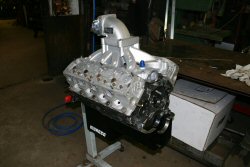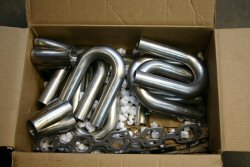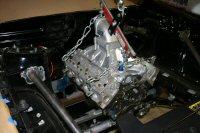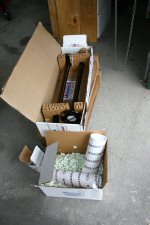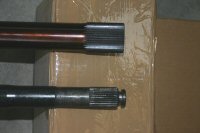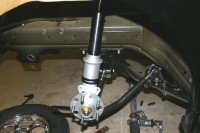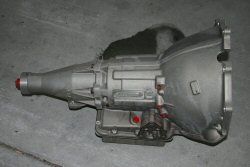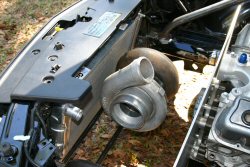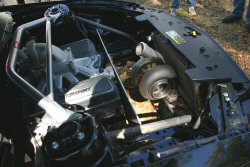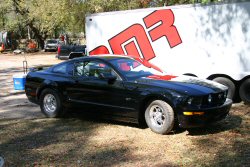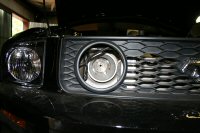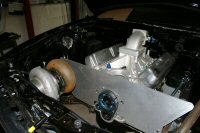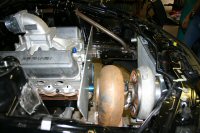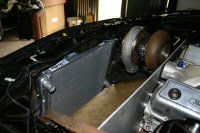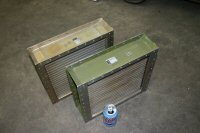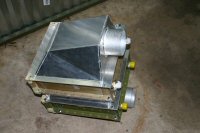BMR 7 Second Mustang Buildup
PAGE 4
February 24th, 2005 - MOTOR
| With the rearend waiting on axles, we assembled a dummy motor to begin making motor mounts and headers. We ordered merged collectors and a bunch of 1.75" stainless u-bends from Burns Stainless. |
| This image shows the motor being positioned for midplate and motor plate fabrication. The midplate is a combination mount and Powerglide conversion. There are a few already on the market but none were wide enough to fit this frame rail so we fabricated our own. To position the motor side to side, the camshaft is centered with the pinion and then it is positioned as high as possible to promote optimal weight transfer. Once the mounts are finished, the next step will be header fabrication. |
March 1st, 2005 -
| We also chose to use Strange 40 spline gun drilled axles. A typical hardening process can only temper the metal to a depth of around 1/4". When you gun drill an axle, it allows the axle to be tempered on the inside and outside which makes it stronger even though there is less material. A gun drilled 40 spline axle is actually lighter than a 35 spline solid axle. In this comparison, you can see the size difference between an OE axle and the 40 spline axle from Strange. |
| Arriving with our rear end components was the Strange GT strut package. Since nobody is making a drag strut for this application yet, we decided give this a shot. This is a lightweight, adjustable strut and brake kit designed for drag race use in applications requiring a tall strut. It requires a custom A-arm and upper mount. After speaking with Strange, we thought we would be able to make them work in our application. The rulebook says that any aftermarket strut and A-arm can be used as long as it mounts to factory locations. We made a bolt-in adapter for the upper mount that bolts to the OE strut tower in place of the rubber factory mount. We also fabricated a custom chromoly A-arm for the bottom that attaches to original mounting locations on the K-member. The picture to the right shows the rough kit mocked up for measurements. With this setup we replaced the factory strut, springs, upper strut mount, A-arm, hub, brake rotor and caliper and dropped 80 lbs. off the front end! |
March 11th, 2005
| With the suspension done and the car sitting back at ride height the motor plates were made. In the meantime, our PTC transmission and torque converter showed up so we were able to make our transmission crossmember at the same time. This transmission has the best of everything from the Kevlar clutches to the Dedenbear case. |
| The very first thing that must be done when building headers is to decide where the turbo will be positioned. The turbo position dictates where every other exhaust and intake tube in the engine bay will run so you have to have all your components at the beginning to map the layout. Before we could decide on a turbo location, we had to have the radiator in the car so we made mounts to install a Griffin radiator as far into the nose as possible. With the radiator mounted, we ended up mounting the turbo directly in the center of the engine bay. This was necessary to allow plenty of room for the 5" downpipe to make the 90 degree transition out of the turbo. The headers and y-pipe will run low to allow room for the downpipe next to the block on the passenger side. |
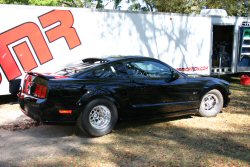 |
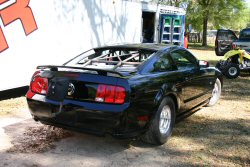 |
March 27th, 2005
Just when things seemed to be moving along, we decided to relocate the turbo. When we started to mock up the headers and y-pipe routing, it was determined that the turbo could be rotated 90 degrees and placed over towards the passenger side. This will keep most of the turbo plumbing on one side of the car and "tidy" up the engine bay. We integrated the turbo mount into the frame rail and lined up the inlet of the turbo with the driving light located in the grille opening. A duct will be fabricated later to channel air directly into the turbo (depending on class rules).
Once the turbo was repositioned, we had to relocate the radiator. Fortunately, there was just enough room to get both the radiator and the turbo inlet betwen the frame rails. Now we can begin fabricating the headers, downpipe and inlet tubing.
Before anything got started, we wanted to make sure that the intercooler was positioned properly so we could map out our intake path. Instead of buying a premade intercooler, we are building one using two highly efficient cores from a military helicopter. These are actually oil coolers and were chosen for there modular convenience and efficiency. The intercooler will be positioned in the front passenger seat.
